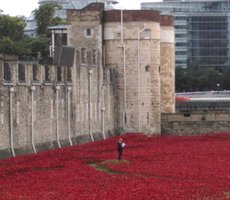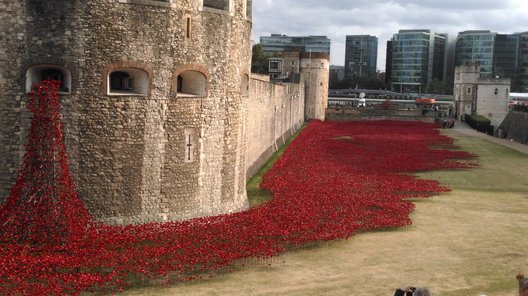The installation ‘Blood Swept Lands and Seas of Red’, designed by ceramic artist Paul Cummins, which commemorates those fallen during the First World War already covers a huge swathe of the Tower of London’s dry moat, writes Joe Cryer.
 What strikes you most is the scale of the installation, yet at the point I saw the moat it was still only in its infancy. Pouring from the outer wall’s North Western corner the poppies spread out along the floor of the moat creating an incredible visual spectacle. The sea of poppies will continue to grow until the last poppy is laid on 11 November, by which point the entire moat will have been filled with 888,246 ceramic poppies, each one representing a British or Colonial fatality during the First World War.
What strikes you most is the scale of the installation, yet at the point I saw the moat it was still only in its infancy. Pouring from the outer wall’s North Western corner the poppies spread out along the floor of the moat creating an incredible visual spectacle. The sea of poppies will continue to grow until the last poppy is laid on 11 November, by which point the entire moat will have been filled with 888,246 ceramic poppies, each one representing a British or Colonial fatality during the First World War.
What is perhaps more moving than the visual aspect of the commemoration is the Roll of Honour conducted every day at twilight, where the names of 180 serving military personnel killed during the First World War are read out. To my horror I realised that to read out the names of every fatality in this manner would take thirteen and a half years. Instead, members of the public can nominate a name for the Roll of Honour, bringing for some an even more personal touch to the already rather poignant installation.
I for one do not know my family history and know of no names to put forward. Yet simply seeing, through this commemoration, the sheer scale of lives lost, it seems quite possible that one of the poppies belongs to some distant member of my family. It is this thought that I assume many people who see the installation will have, and the reach of the First World War and the scale of loss on display at The Tower means that it makes little difference whether you come from London, Auckland or New Delhi.

The ceramic poppies are also more than just a display. Each poppy is available to be purchased (which you can do here) which organisers hope will raise millions of pounds for a number of charities who help injured servicemen and servicewomen and their families today.
I expect I will be returning to the Tower of London at least once over the course of the next couple of months to see the poppies again as they spread to cover the ground in a sea of red. And I would urge anyone and everyone to go and see it if you can, because it is both beautiful and haunting in equal measure, as I feel a fitting commemoration should be.
Joe Cryer is an intern at British Future





